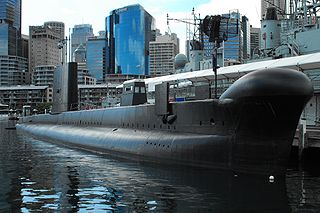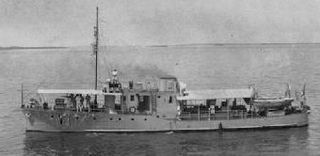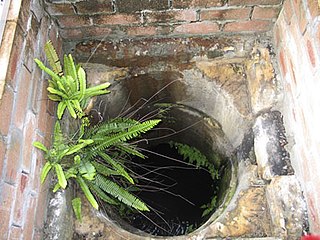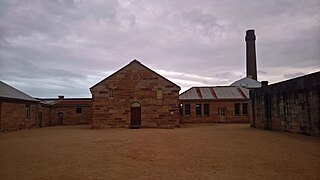
HMAS Onslow was one of six Oberon-class submarines operated by the Royal Australian Navy (RAN). The submarine was named after the town of Onslow, Western Australia, and Sir Alexander Onslow, with the boat's motto and badge derived from Onslow's family heritage. Ordered in 1963, Onslow was laid down at the end of 1967 by Scotts Shipbuilding and Engineering Company in Scotland, launched almost a year later, and commissioned into the RAN at the end of 1968.

Cockatoo Island is a UNESCO World Heritage Site at the junction of the Parramatta and Lane Cove River in Sydney Harbour, New South Wales, Australia.

Royal Navy Dockyards were state-owned harbour facilities where ships of the Royal Navy were built, based, repaired and refitted. Throughout its history, the Royal Navy has made extensive use of private shipyards, both at home and abroad; but at the same time it also had a policy of establishing and maintaining its own dockyard facilities. Portsmouth was the first ; it was followed by Deptford, Woolwich, Chatham and others. By the 18th century, Britain had a string of these state-owned naval dockyards, located not just around the country but across the world; each yard was sited close to a safe harbour or anchorage used by the fleet. Most Royal Dockyards had a dual function, providing for both ship building and ship maintenance. Over time, they accrued additional on-site facilities for the support, training and accommodation of naval personnel.

The Cockatoo Island Dockyard was a major dockyard in Sydney, Australia, based on Cockatoo Island. The dockyard was established in 1857 to maintain Royal Navy warships. It later built and repaired military and civilian ships, and played a key role in sustaining the Royal Australian Navy. The dockyard was closed in 1991, and its remnants are heritage listed as the Cockatoo Island Industrial Conservation Area.

HMAS Warrego, named for the Warrego River, was a River-class torpedo-boat destroyer of the Royal Australian Navy (RAN). Ordered in 1909, construction of the destroyer started in England, but she was then broken down and reassembled at Cockatoo Island Dockyard in order for the Australian shipbuilding industry to gain experience in warship construction. Warrego was commissioned into the RAN in 1912, and spent her early career operating in Australian waters.

Mort's Dock is a former dry dock, slipway, and shipyard in Balmain, New South Wales, Australia. It was the first dry dock in Australia, opening for business in 1855 and closing more than a century later in 1959. The site is now parkland. The surviving remnants were added to the New South Wales State Heritage Register on 14 January 2011.

HMAS Vigilant was an auxiliary patrol boat serving with the Royal Australian Navy during the Second World War. Notably it was the 120th ship built by the Cockatoo Island Dockyard and the first aluminium ship built in Australia.

Fitzroy Dock is a heritage-listed dockyard at the former Cockatoo Island Dockyard, Cockatoo Island, Sydney Harbour, New South Wales, Australia. It was added to the Australian Commonwealth Heritage List on 22 June 2004.

HMAS Koolonga was a 4,260 gross tons cargo ship built by Sunderland Shipbuilding Company, South Dock Sunderland, England, in 1914 and bought by McIlwraith, McEacharn Line Pty Ltd, Melbourne and named SS Koolonga. She was requisitioned by the Royal Australian Navy on 6 August 1914, as a collier and supply ship. She was returned to her owners in late 1915. She was sold in 1937 to Madrigal & Company, Philippines and renamed Paz. She was scuttled during the Second World War at Sourabaya Harbour in 1942 and was later salvaged by the Imperial Japanese and renamed Hatsu Maru. While at anchor in Manila Bay, Philippines on 13 November 1944, she was attacked by United States Navy carrier aircraft and was sunk.

South Brisbane Dry Dock is a heritage-listed dry dock at 412 Stanley Street, South Brisbane, City of Brisbane, Queensland, Australia. It was designed by William David Nisbet and built from 1876 to 1887. It is also known as the Government Graving Dock. It was added to the Queensland Heritage Register on 21 October 1992.

The Underground Grain Silos are heritage-listed silos at Cockatoo Island, Sydney Harbour, New South Wales, Australia. It was added to the Australian Commonwealth Heritage List on 22 June 2004.

Biloela House is a house at the centre of a heritage-listed historic precinct on Cockatoo Island, Sydney Harbour, New South Wales, Australia. It was added to the Australian Commonwealth Heritage List on 22 June 2004.

Prison Barracks Precinct is a heritage-listed prison precinct at Cockatoo Island, Sydney Harbour, New South Wales, Australia. It was added to the Australian Commonwealth Heritage List on 22 June 2004.

Convict Barracks Block is a heritage-listed convict barracks within the Prison Barracks Precinct, Cockatoo Island, Sydney Harbour, New South Wales, Australia. It was added to the Australian Commonwealth Heritage List on 22 June 2004.

Military Guard Room is a heritage-listed military installation within the Prison Barracks Precinct, Cockatoo Island, Sydney Harbour, New South Wales, Australia. It was added to the Australian Commonwealth Heritage List on 22 June 2004.

Mess Hall is a heritage-listed part of the Prison Barracks Precinct at Cockatoo Island, New South Wales, Australia. It is also known as Mess Hall (former). It was added to the Australian Commonwealth Heritage List on 22 June 2004.

Cockatoo Island Industrial Conservation Area is a heritage-listed protected area relating to the former Cockatoo Island Dockyard at Cockatoo Island, Sydney Harbour, New South Wales, Australia. It was added to the Australian Commonwealth Heritage List on 22 June 2004.

Power House & Pump House is a heritage-listed power house and pumping station at Cockatoo Island, Sydney Harbour, New South Wales, Australia. It was added to the Australian Commonwealth Heritage List on 22 June 2004.

The Garden Island Naval Precinct is a heritage-listed naval base and defence precinct located at Cowper Wharf Roadway in the inner eastern Sydney neighbourhood of Garden Island in the City of Sydney local government area of New South Wales, Australia. The precinct was built from 1856. It includes the HMAS Kuttabul naval base, formerly known as HMAS Penguin. The property is owned by Australian Department of Defence. It was added to the Commonwealth Heritage List on 22 June 2004 and the New South Wales State Heritage Register on 12 November 2004.

Sydney Cove West Archaeological Precinct is a heritage-listed precinct that contains The Rocks police station, the Museum of Contemporary Art Australia, car park, parks, shops and roads located at 112-156 George Street, in the inner city Sydney suburb of The Rocks in the City of Sydney local government area of New South Wales, Australia. The precinct previously contained a commissariat store, Maritime Services Board offices, dockyard and Department of Labour & Industry offices. Buildings in the precinct were developed in various stages since 1797 to date, with heritage-listed buildings dating from 1797 to 1939. The precinct is also known as the Museum of Contemporary Art, Maritime Services Board, Colonial Government naval dockyard, Commissariat Stores, Colonial Hospital, Kings and Queens Wharf and First Fleet Park. The property is owned by Property NSW, an agency of the Government of New South Wales. It was added to the New South Wales State Heritage Register on 5 August 2011.






















